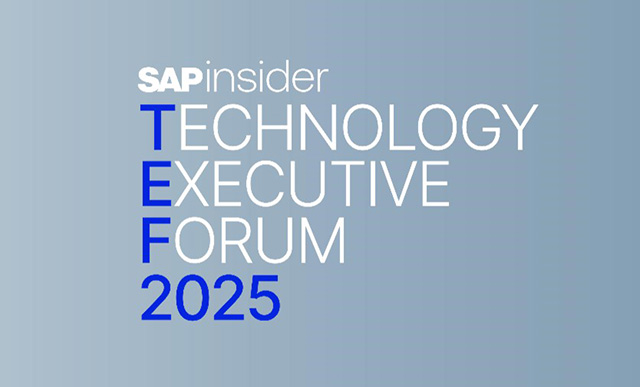SAP Smart Sensing
Filter By
Browse By
- SAP Analytics and AI
- SAP Application Development and Integration
- All SAP Application Development and Integration
- SAP ABAP
- SAP ABAP Development Tools
- SAP ABAP Test Cockpit
- SAP API Management
- SAP BAPI
- SAP Basis
- SAP BRF
- SAP Business Application Studio
- SAP CMS
- SAP Design Studio
- SAP Development Tools
- SAP DevOps
- SAP EAI
- SAP EDI
- SAP Extension Suite
- SAP Fiori
- SAP Fiori Elements
- SAP Integration Suite
- SAP Low Code Application Development
- SAP Low Code Automation
- SAP Netweaver
- SAP Release Management
- SAP UI5
- SAP Web Application Server
- SAP Web IDE
- SAP Business Process Management
- SAP Center of Excellence
- SAP CIO
- SAP Customer Experience
- SAP Data and Data Management
- All SAP Data and Data Management
- SAP BW
- SAP BW/4HANA
- SAP Crystal Reports
- SAP Data Archiving
- SAP Data Center
- SAP Data Governance
- SAP Data Integration
- SAP Data Migration
- SAP Data Quality
- SAP Data Services
- SAP Data Strategy
- SAP Data Visualization
- SAP Data Warehouse Cloud
- SAP DMS
- SAP Document Control
- SAP EIM
- SAP ETL
- SAP ETL Tools
- SAP HANA
- SAP HANA Administration
- SAP HANA Deployment Infrastructure
- SAP HANA Studio
- SAP Master Data
- SAP Master Data Governance
- SAP MDM
- SAP Enterprise Architect
- SAP Enterprise Asset Management
- SAP ERP
- SAP Finance
- All SAP Finance
- SAP Accounting
- SAP AR AP
- SAP Asset Accounting
- SAP Billing Systems
- SAP BPC
- SAP BRIM
- SAP Cash Management
- SAP Central Finance
- SAP Controlling
- SAP COPA
- SAP Cost Center Accounting
- SAP Currency Risk
- SAP e-invoicing
- SAP FICO
- SAP Finance Automation
- SAP Advanced Financial Closing
- SAP Financial Consolidation
- SAP Financial Planning
- SAP FX Risk
- SAP General Ledger
- SAP Global Tax Management
- SAP Hyperion
- SAP Order to Cash
- SAP Payment Processing
- SAP Profitability Analysis
- SAP Rebate Management
- SAP S/4HANA Finance
- SAP SWIFT Compliance
- SAP Treasury Management
- SAP Universal Journal
- SAP Governance Risk and Compliance
- SAP Human Capital Management
- SAP Intelligent Technologies
- SAP Platform and Technology
- All SAP Platform and Technology
- SAP Business Technology Platform
- SAP Cloud
- SAP Cloud Connector
- SAP Cloud Integration Platform
- SAP Cloud Migration
- SAP Cloud Platform
- SAP Cloud Providers
- SAP Cloud Strategy
- SAP Digital Signature
- SAP Container Platform
- SAP HANA Enterprise Cloud
- SAP Digital Asset Management
- SAP Smart Forms
- SAP HEC
- SAP Digital Integration Hub
- SAP Hyperscalers
- SAP Infrastructure
- SAP Messaging
- SAP Quality and Testing
- SAP Security
- SAP Spend Management
- SAP Supply Chain Management
- All SAP Supply Chain Management
- SAP APO
- SAP Asset Management
- SAP Business Network
- SAP Digital Manufacturing Cloud
- SAP Digital Twin
- SAP EWM
- SAP IBP
- SAP Inventory Management
- SAP Label Printing
- SAP Logistics
- SAP Manufacturing
- SAP Manufacturing Automation
- SAP MES
- SAP MII
- SAP MM
- SAP MRO
- SAP MRP
- SAP Order Management
- SAP Plant Maintenance
- SAP PLM
- SAP Production Planning
- SAP S&OP
- SAP SD
- SAP SPM
- SAP Supply Chain Planning
- SAP Track and Trace
- SAP Transportation Management
- SAP System Administration
What Is Smart Sensing?
Sensors have been used in industry for decades to capture specific parameters like temperature. Smart sensors are an evolution of legacy sensors and leverage recent advances in technologies like Internet of Things (IoT) and cloud. Unlike a traditional sensor, a smart sensor can perform advanced tasks such as data conversion, data processing, analytics, and communicating with external devices and the cloud. Many smart sensors can do self-assessment and self-calibration, making them an essential part of digital twins. The data from smart sensors can be leveraged for a plethora of applications, like predictive planning.
What Is Smart Sensing?
Sensors have been used in industry for decades to capture specific parameters like temperature. Smart sensors are an evolution of legacy sensors and leverage recent advances in technologies like Internet of Things (IoT) and cloud. Unlike a traditional sensor, a smart sensor can perform advanced tasks such as data conversion, data processing, analytics, and communicating with external devices and the cloud. Many smart sensors can do self-assessment and self-calibration, making them an essential part of digital twins. The data from smart sensors can be leveraged for a plethora of applications, like predictive planning.
What Is SAP Smart Sensing?
Smart sensing is a capability within the SAP Internet of Things offering that leverages SAP Fiori to identify and track physical objects maintained in SAP S/4HANA. The identification and tracking is done primarily by scanners and smart sensors. Compared to classic IoT scenarios, the SAP smart sensing approach brings the following advantages:
- Tracking of single events rather than recording of continuous data streams significantly reduces the amount of data to process.
- Using auto-ID tags instead of sensors reduces costs.
- Tagging of single items that are part of a delivery or a handling unit allows for a finer granularity and higher precision of the data collected.
While the applications can span multiple functions, a key function that can leverage smart sensing extensively is supply chain. With the help of smart sensors and other technologies like artificial intelligence and machine learning, organizations can build smart, kinetic supply chains, as highlighted in this webinar.
Key Considerations for SAPinsiders
SAP smart sensing is a robust capability to help organizations build components of the intelligent enterprise. However, there are certain key aspects that SAPinsiders need to keep in perspective when embarking on this journey:
Understand the difference between conventional and smart sensors. As mentioned earlier, sensors have been used in industry for a while, but smart sensors take this capability much further. Understanding the “smart” aspect of sensors will allow you to understand where and how to use them.
Think beyond just tracking. While there is no doubt that smart sensors can help track flows or processes in real time, the data often captured by these sensors can be used extensively for generating additional insights. Key advanced analytics approaches like simulation, optimization, and predictive analytics can be leveraged using this data to generate new insights for organizations.
Think end-to-end. A powerful capability of smart sensors is that they can be used to build end-to-end solutions, specifically in process intense functions like supply chains. You can design end-to-end solutions to make your enterprise more resilient and agile.
492 results
-

- SAP Smart Forms
 Premium
Premium
Using Standard Text with Variables in SAP Smart Forms
Reading time: 6 mins
Learn how to use standard text with variables in SAP Smart Forms. Key Concept Smart Forms is a tool for creating and maintaining forms within SAP systems, such as CRM, SCM, SRM, ERP HCM, and Healthcare. Smart Forms provides an easy-to-use graphical user interface that allows you to create and modify company-specific forms to communicate...…
-

- SAP Data Integration
 Premium
Premium
Managing Data with SAP Solutions: SAP HANA and non-HANA Use Cases
Reading time: 17 mins
See some examples of integration solutions based on SAP-provided replication tools that you can use to integrate SAP and non-SAP applications. The tools support a wide variety of data types (structured and unstructured) and formats (including data streams). Key Concept The new SAP HANA replication and consolidation capabilities can simplify the architecture of the solution...…
-

 Premium
Premium
Create Versatile HR-Related Forms in HR Forms Workplace
Reading time: 21 mins
Design flexible, attractive HR-related forms through HR Forms Workplace. HR Forms Workplace is the central tool for creating HR-related forms through SAP Smart Forms or PDF Forms. Find out how to easily select HR-related data to create forms specific to your company without writing any extraction routines. Key Concept HR Forms Workplace (transaction HRFORMS) is...…
-
-

- SAP HANA
 Premium
Premium
SAP Data Services Part 3: How to Extract, Transform, and Load Data into SAP HANA
Reading time: 17 mins
Examine and compare the classic SAP Data Services approach for extracting, transforming, and loading (ETL) processes to the functionality that is native to SAP HANA to determine optimal integration. Key Concept Certain extract, transform, and load (ETL) processes have been pushed to SAP HANA, which directly affects the integration with SAP Data Services. ETL is...…
-

SAP Data Services: How to Extract, Transform, and Load Data into SAP HANA
Reading time: 15 mins
Examine and compare the classic SAP Data Services approach for extracting, transforming, and loading (ETL) processes to the functionality that is native to SAP HANA to determine optimal integration. Membership Required You must be a member to access this content.View Membership LevelsAlready a member? Log in here
-

Make Smarter Business Decisions
Reading time: 7 mins
Augmented analytics is defined by Wikipedia as an approach to analytics that employs the use of machine learning and natural language processing to automate analysis processes typically done by data scientists. Smart Assist is a collective group of features that enable augmented analytics to occur in SAP Analytics Cloud. The Smart Assist portfolio enables features…
-

ABAP Development Chat
Reading time: 21 mins
In this live chat, insiderBOOKS author Faisal Altaf answered questions on using ABAP in real-world scenarios. If you missed the chat or need a refresher, you may view the chat replay or read the edited transcript below. Meet the panelist: Faisal Altaf Faisal has nine years of experience in IT, seven-and-half years of which have been...…
-
-

 Premium
Premium
Inventory Planning and Optimization with SAP Advanced Safety Stock Planning and SAP SmartOps
Reading time: 27 mins
Read two case studies to learn how to implement SAP APO Advanced Safety Stock Planning (ASSP) and SAP SmartOps Enterprise Inventory Optimization (EIO). Key Concept SAP SmartOps Enterprise Inventory Optimization (EIO) provides a comprehensive, enterprise-wide process for optimizing, managing, and monitoring inventory stocking levels for finished product and raw material components across the supply chain. ...…
-

SAP Announces Acquisition of SmartRecruiters
Reading time: 4 mins
SAP has announced its acquisition of SmartRecruiters to enhance its SAP SuccessFactors suite with advanced talent acquisition capabilities, including AI-enabled recruiting, aiming to streamline the hiring process for customers and ensure compliance and responsible AI usage.
-

 Premium
Premium
Extend Your Web Intelligence Filtering with an IP Address-Based Smart Filter
Reading time: 16 mins
Learn step-by-step guidelines for creating and implementing an IP address-based smart Web Intelligence filter solution to extend SAP Web Intelligence’s filtering capabilities. In addition to IP addresses, this smart filter tool works well with computer names, local network names, or Windows logon users. Using any of these options, you can implement a smart Web Intelligence...…
Become a Member
Unlimited access to thousands of resources for SAP-specific expertise that can only be found here.
Become a Partner
Access exclusive SAP insights, expert marketing strategies, and high-value services including research reports, webinars, and buyers' guides, all designed to boost your campaign ROI by up to 50% within the SAP ecosystem.
Upcoming Events
-

SAPinsider Technology Executive Forum
December 02 - 03, 2025
Phoenix, Arizona
United States
View Event
Related Vendors
Your request has been successfully sent

